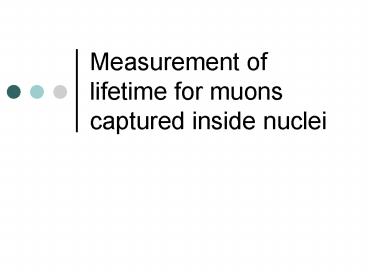Measurement of lifetime for muons captured inside nuclei
1 / 37
Title:
Measurement of lifetime for muons captured inside nuclei
Description:
3. One electron is replaced by muon and transitions down to the muonic atom K-shell around sec ... Only negative charged muon may be captured. The difference of ... –
Number of Views:121
Avg rating:3.0/5.0
Title: Measurement of lifetime for muons captured inside nuclei
1
Measurement of lifetime for muons captured inside
nuclei
2
Content
- 1. Introduce of the muon capture
- 2. The difference of the free decay and captured
decay - 3. How to measure the capture event
- 4. The apparatus of this experiment
- 5. The analysis of this experiment
- 6. Summary
3
Introduce of the muon capture
4
Muonic atom
- 1. Muon entering the matter
- 2. Electromagnetic interactions
- 3. One electron is replaced by muon and
transitions down to the muonic atom K-shell
around sec
5
Muonic atom
- Due to the relatively high mass of muon, the Bohr
radius of muon is 206.7 times smaller than
electron orbit - Only negative charged muon can form muonic atom
6
Muon capture
- There are two process of muon capture
- µp?n?
- µp?n??
- The process contains no charged particles in the
results - The process is relatively fast
- Only negative charged muon may be captured
7
The difference of the free decay and captured
decay
8
About muon lifetime
- Muon lifetime is a typical process of radioactive
decay. - The radioactive decay is a random process,
independent of the previous life of the particle.
9
Muon lifetime distribution
is a constant decay rate
The number of decayed muon
The number of muons at time t
We call the muon lifetime is
10
The example of muon lifetime measurement
11
Muon captured lifetime distribution
- The capture decay lifetime is also a radioactive
decay. - Because of the relative short lifetime of capture
process, the lifetime we measured will less than
free decay lifetime.
12
How the muon capture affect the muon lifetime
measurement
- The free decay lifetime
- The capture decay lifetime
- Here the A and C are constants, B is the mean
lifetime of freedecay, D is the mean lifetime of
capture decay, E is the randomaccidental
coincidence which produced by the noise.
13
The example of muon capture lifetime measurement
14
How to measure the capture event
15
How to measure the capture process
- The two process of capture are
- µp?n?
- µp?n??
- We can try to measure the n or ?-ray
16
Measuring the ?-ray
- ?-ray are more efficiently detected by high Z
materials. - To detect the ?-ray, the materials cross
sections of photoelectric and pair production
must large compared to the compton scattering
cross section - NaI is a good material to detect the ?-ray.
17
Measuring the neutron
- The most common method to detect neutron is using
another charged particles to replace the kinetic
energy of neutron. - The neutron in the plastic scintillator or
organic scintillator may have a strong
probability to collide with the hydrogen's proton
and transfer kinetic energy to the proton.
18
The apparatus of this experiment
19
The experiment flow chart
20
The detectors
µ
n
p
21
Experiment setup
22
TDC flow chart
23
ADC flow chart
24
The good event nim timing chart
µ
n
p
25
The cross event1 nim timing chart
particle
26
The cross event2 nim timing chart
particle
27
Muon flux
- The flux of sea level muons is almost
- for horizontal detectors
- For this experiment, the effective area of the
detector is - The probability of two cosmic rays comes in 10
micro-sec is almost
28
The analysis of this experiment
29
The qualitative analysis of adc
30
(No Transcript)
31
(No Transcript)
32
The qualitative analysis of tdc
33
Cu target quantitative analysis
34
Fe target quantitative analysis
35
Al target quantitative analysis
36
Summary
37
The result
The average result
The experiment result































